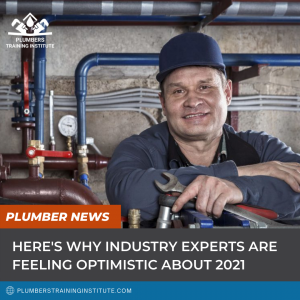Here’s Why Industry Experts Are Feeling Optimistic About 2021
Published on February 10, 2021 by Nate Bortz

While there’s no doubt that 2020 was a difficult year for most of the country (and the world), plumbing industry professionals are looking to 2021 with cautious optimism. Below we’ll go over a summary of the National Kitchen & Bath Association’s (NKBA) annual Market Outlook Report, as well as some 2021 predictions from industry experts.
NKBA StudyPredicts Large Kitchen & Bath Remodel Project Increase
According to the data gathered by the NKBA, 2021 residential bath and kitchen remodeling projects are expected to grow to $158.6 billion in 2021, a 16.6% increase from 2020.
“Last year, homeowners started the work of improving their living spaces with DIY projects. This year, with early distribution of the vaccine and other measures to reduce the public health impact of the virus, we expect to see continued renovations and more projects requiring our members,” said Bill Darcy, NKBA CEO.
NKBA research analyst Robert Isler says plumbing professionals should expect to see a shift to more “higher-end” and labor intensive home renovations in 2021. In 2020, more homeowners completed DIY-level projects due to a reluctance of having anyone in their homes. But in 2021, surveyed homeowners are expecting COVID-19 risks to diminish therefore want to address delayed remodels.
Industry Expert Predictions
Recently, Plumbing & Mechanical Engineer Magazine asked many plumbing industry experts for their opinions on what 2021 holds. Here are some of the highlights.
Supporting NKBA’s project growth report, Kerry Stackpole, FASAE, CAE, CEO and executive director of Plumbing Manufacturers International said “individuals are choosing to invest disposable income into home improvements — many of which are plumbing related. We expect this general trend to continue into 2021, and according to the most recent PMI Market Outlook reports, retail sales of building materials and supplies through outlets such as Home Depot and Lowe’s continued to grow into the third quarter of 2020.”
Bruce Carnevale, CEO of Bradford White Corp., expects to see connected technology really start to take a foothold in the industry in 2021.
“Most of the growth in connected technology is going to be driven by the regulatory environment,” he says. “Washington, for example, has instituted requirements for grid-enabled products, which requires connected technology for heat pump water heaters. Demand for the technology will begin to hit critical mass in 2021, so that is definitely poised for growth.”
What a New Administration Might Mean for the Industry
According to Dominic Sims, CEO of the International Code Council, there are two key considerations for the industry to watch for now that Joe Biden is president: his support for increased infrastructure spending and workforce development.
“The president’s infrastructure platform calls for a significant investment in the country’s water infrastructure, as well as workforce training,” Sims says.
Throughout the campaign, Biden supported investments to repair water pipelines and sewer systems, replace lead service pipes, upgrade treatment plants, and the construction of 1.5 million homes and public housing units. He also proposed a $50 billion investment in workforce training including community-college business partnerships and apprenticeships.
“Programs to increase interest in the trades is critical for the HVAC industry, given much of the plumbing, mechanical and HVAC workforce is reaching the age of retirement. Without an emphasis on programs to increase interest in the trades, the industry could be facing a severe shortage of talent that will limit its overall growth and innovation,” Sims said.
Possible Challenges
There are plenty of reasons to be excited for what this year holds, but there are also potential challenges.
“This is usually the time of year when local governments start making projections on proposed budgets,” Sims notes. “However, the tax base is a driver for most local economies, and this has been all-but non-existent for more than three-fourths of 2020. A September 2020 report from the Brookings Institute, a non-partisan think tank, projects that as a result of the pandemic, state and local income tax revenues will decline 4.7% in 2020; 7.5% in 2021; and 7.7% in 2022.”
Sims thinks the cost of lower tax revenue could bring greater delays in inspections and permit approvals which could, in turn, create “a ripple effect for all related industries.”
Despite these challenges, there are plenty of things in the plumbing industry to be excited about in 2021. What are you looking forward to? Let us know on social media!
